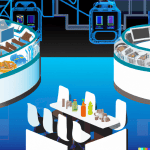The restaurant industry has undergone a major tech revolution in recent years. From food ordering apps to automated kitchen devices, new innovations are dramatically changing the dining experience for restaurants and customers alike. In this post, we’ll highlight some of the most impactful restaurant technologies that have been game-changers for the industry.
Online Ordering and Delivery Platforms
Apps and websites like UberEats, DoorDash, and GrubHub have become essential for many restaurants. These platforms allow customers to browse menus, order food online, and have it delivered straight to their door. For restaurants, it hugely expands their potential customer reach and provides valuable data on the most popular menu items. Although the commission fees can be high, for many smaller restaurants the extra revenue stream has been a lifeline, especially during the pandemic.
Touchscreen Ordering Kiosks
Within restaurants, self-service touchscreen kiosks (like those provided by OneDine) are speeding up orders and minimizing long lines at the register. Customers can leisurely browse menu options, customize orders, and pay right at the kiosk. For staff, it reduces bottlenecks from cashier orders and improves order accuracy. From big chains like McDonalds to mom-and-pop shops, kiosks are becoming a fixture in all sorts of dining establishments.
Smart Kitchen Systems
Behind the scenes, advanced IoT technology is getting integrated directly into commercial kitchen equipment. Bluetooth or wifi-enabled ovens can track cooking times and temperatures then automatically adjust settings. RFID tags monitor food ingredients and track expiration dates. Handheld devices scan orders from kiosks and sync instructions to kitchen displays so orders pop up in real-time. When implemented properly, smart kitchen tech leads to faster service, less food waste, and more efficient operations.
Digital Menu Innovation
Tablets (like the OneDine otg) have also made their way onto restaurant tables for customers to browse digital menus and place orders without waiting on servers. But some eateries are taking it further with interactive AR menus or digital wine walls that showcase information with a swipe. Customer data can also help restaurants provide personalized recommendations and highlight popular dishes. As digital menus catch on, they open opportunities to delight and engage customers in new ways.
Even moving into the future, technology will undoubtedly continue disrupting the restaurant space. Integrating innovations to improve service, efficiency, and data insights provides a major competitive advantage to savvy establishments. But at the end of the day, the dining experience still comes down to good food, drinks, and hospitality. The restaurants that balance tech enhancements with their core offerings will thrive in the years ahead.





